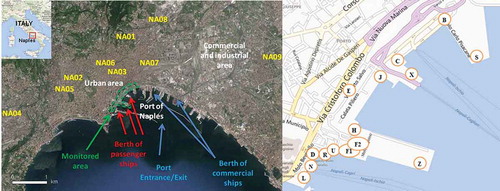Abstract
Two experimental monitoring campaigns were carried out in 2012 to investigate the air quality in the port of Naples, the most important in southern Italy for traffic of passengers and one of the most important for goods. Therefore, it represents an important air pollution source located close to the city of Naples. The concentrations of sulfur dioxide (SO2), nitrogen dioxide (NO2), and BTEX (benzene, toluene, ethylbenzene, and xylenes) in the air were measured at 15 points inside the Naples port area through the use of passive samplers. In addition, a mobile laboratory was positioned in a fixed point inside the port area to measure continuous concentration of pollutants together with particulate matter, ambient parameters, and wind direction and intensity. The pollution levels monitored were compared with those observed in the urban area of Naples and in other Mediterranean ports. Even though the observation time was limited, measured concentrations were also compared with limit values established by European legislation. All the measured pollutants were below the limits with the exception of nitrogen dioxide: its average concentration during the exposition time exceeded the yearly limit value. A spatial analysis of data, according to the measured wind direction and intensity, provided information about the effects that ship emissions have on ambient air quality in the port area. The main evidence indicates that ship emissions influence sulfur dioxide concentration more than any other pollutants analyzed.
Implications: Two monitoring campaigns were carried out to measure BTEX, SO2, NO2, and PM10 (particulate matter with an aerodynamic diameter <10 μm) air concentrations in the port of Naples. NO2 hourly average and PM10 daily average comply with European legislative standards. Spatial variation of pollutants long the axis corresponding to the prevailing wind direction seems to indicate a certain influence of ship emissions for SO2. For NO2 and PM10, a correlation between concentrations in the harbor and those measured by the air quality monitoring stations sited in the urban area of Naples was observed, indicating a possible contribution of the near road traffic to the air pollution in the port of Naples.
Introduction
Ship emissions in port areas are dispersed in the atmosphere and in many cases transported to the nearby urban areas, affecting air quality and jeopardizing people’s health and quality of life (Ault et al., Citation2009; Viana et al., Citation2014). Air pollution due to ship emissions mainly concerns sulfur dioxide (SO2), nitrogen dioxide (NO2), and particulate matter. Besides that the European Union (EU) legislation enforces the use of a cleaner fuel in terms of sulfur content during ship hotelling longer than 2 hr. Ships at berth are also still responsible for air pollution in the port areas, mainly because of the use of engines for supplying auxiliary devices (Adamo et al., Citation2014).
Several studies (modeling and experimental) dealing with air pollution from ports are reported in the literature. Monitoring campaigns were carried out in port areas and nearby urban areas (Marr et al., Citation2007). Schembari et al. (Citation2012) demonstrated a strong relationship between sulfur content in the fuel and SO2 air concentrations in four Mediterranean ports. Recent studies show the contribution of ship emissions on fine and ultrafine particles (Healy et al., Citation2009; Donateo et al., Citation2014). Contini et al. (Citation2011) stated that ships contribute directly to 10% of polycyclic aromatic hydrocarbon (PAH) concentration in the air of Venice and to almost 8% of PM2.5 (particulate matter with an aerodynamic diameter <2.5 µm). Several studies recognized some metals as tracer of particulate produced by ships, such as vanadium and nickel, which are generally used as tracers of oil combustion emissions. In the case of ship emissions, correlation of V with ship fluxes was observed by Mueller et al. (Citation2011), Zhao et al. (Citation2013), and Cesari et al. (Citation2014).
Air quality contribution by port activities was also assessed through the use of air dispersion models. Saxe and Larsen (Citation2004) focused their study on three Danish ports, highlighting a considerable contribution to NO2 and PM10 (PM with an aerodynamic diameter <10 µm) air concentrations, posing health problems to people living or working near the harbors (Matthias et al., Citation2010). Gariazzo et al. (Citation2007) applied a three-dimensional (3D) Lagrangian particle dispersion model to Taranto (Italy) port affected by multiple pollution sources (harbor, traffic, industrial). They conclude that about 9% of SO2 and NO2 originated from harbor activities. Assessment of port emissions can require the use of emission factors depending on the ship category, tonnage, and the specific activity: hotelling (operations while stationary at berth) and maneuvering (moving into or out of port) (European Commission [EC], Citation2002). Lucialli et al. (Citation2007) used this classification to Ravenna port, showing a good correlation between NO2 predicted and that measured by air quality monitoring stations.
An interest in atmospheric port emissions was also demonstrated by several European researches and demonstration projects: PEARL project (www.pearl-project.eu), APICE project (www.apice-project.eu), CESAPO project (http://www.cesapo.upatras.gr), and CNSS project (www.cnss.no/project-description).
The aim of this paper is to characterize the air quality in the port area of Naples (40°51′19″N, 14°15′36″E). The port of Naples has 75 berths, with a total length of 11 km, an annual traffic of about 22 × 106 t and 6 × 106 millions of passengers and of about 48,000 vessels (http://www.porto.napoli.it/). It is located very close to the urban area and to a commercial and industrial area of Naples (). The National Institute of Environmental Protection and Research (ISPRA) in two emission inventories (ISPRA, Citation2012, Citation2014), both based on national data, shows that the effect on air quality caused by the emissions of maritime vessels had increased from 1990 to 2012. In particular, the percentage of SO2 emissions coming from the port activities of Naples (ISPRA, Citation2012) is significant (about 40%).
In order to give an assessment of air quality in the port of Naples, two experimental monitoring campaigns were carried out to measure concentrations of BTEX (benzene, toluene, ethylbenzene, and xylenes), NO2, SO2, and PM10 inside the port area. Air concentrations were compared with limit values established by European legislation concerning air quality and data from the monitoring stations located in the urban area of Naples. Furthermore, the data were correlated with wind intensity and direction in order to gain an understanding of what contribution ship emissions have on air quality in the monitored area.
Instruments and Methods
Two monitoring campaigns were performed in 2012, spring (April) and autumn (November): the first had a duration of 14 days, whereas the second had a duration of 19 days. Cylindrical passive samplers Radiello (Fondazione Salvatore Maugeri-IRCCS, Padova, Italy) were positioned in 15 sites of the port (, right side) to analyze SO2, NO2, and BTEX (benzene, toluene, ethylbenzene, and xylenes). Sampling point F2 corresponds also to the location of a mobile laboratory equipped with continuous analyzers of SO2, NO2, NO, CO, and PM10. Wind intensity and direction were also measured in F2.
At the end of each monitoring campaign, the passive samplers were collected and analyzed in a laboratory to obtain atmospheric average concentration in the period. Although 15 samplers for each species were exposed during both campaigns, numbers of valid samples are 12 and 6 for the first and second monitoring; some samplers were lost during the exposure time, however, probably due to acts of vandalism. For analyses of SO2 and NO2, the cartridges were extracted by using 5 mL of water and stirring vigorously for 1 min. Then, sulfite and sulfate ion concentrations were determined by ion chromatography analysis and nitrite ion concentration by absorbance measurement of samples at 537 nm (American Public Health Association [APHA], American Water Works Association [AWWA], and Water Environment Federation [WEF], Citation1998). Detection limits are 0.06 and 0.1 μg/m3 for NO2 and SO2, respectively. BTEX were chemically desorbed by using 2 mL of carbon disulfide (CS2) with an extraction time of 30 min. The extract was then analyzed by means of gas chromatography with flame ionization detection (GC-FID). 2-Fluorotoluene was used as an internal standard because its retention time does not interfere with other compounds in the chromatogram.
Analytical method: 100% dimethylpolysiloxane column, 50 m × 0.2 mm × 0.5 µm (Agilent J&W HP-PONA); nitrogen flow: 0.63 mL/min; head pressure: 20 psi; split injection (25:1): 0.5 µL; injector temperature: 240 °C; oven initial temperature: 35 °C for 5 min, 5 °C/min up to 90 °C, isotherm for 10 min, 10 °C/min up to 180 °C, final isotherm for 5 min. The detection limit of this method for each aromatic compound is 0.05 μg/m3.
The accuracy and consistency of results of passive samplers were checked by comparing the results of a pair of samplers located in two sites very close to each other (F1 and F2). It was on the average ±20%. Concerning continuous gaseous analyzers of mobile laboratory (site F2), NO2 was measured with chemiluminescence detector (CLD), whereas SO2 was measured using fluorescence detector. In addition, the mobile laboratory was also equipped with a PM10 continuous analyzer based on orthogonal nephelometry (UniTec srl, LSPM10) and a weather station for ambient condition monitoring. Subsequently, all available data were analyzed in order to obtain hourly and daily average concentrations. Analyzers of the mobile laboratory used the same detection techniques for air quality to those of the monitoring stations of Naples. This homogeneity allowed us to make the comparison between the monitored species in the port with air concentrations in the urban area of Naples.
Results
Meteorological conditions and marine traffic during the monitoring campaigns
Temperatures monitored during the two campaigns are reported in . Besides the temperature ranges that overlap (between 8 and 24 °C), the weather in the second campaign was characterized by warmer temperatures than those of the first one.
Figure 2. Relative frequency distribution of ambient temperatures in the port of Naples during the monitoring campaigns.
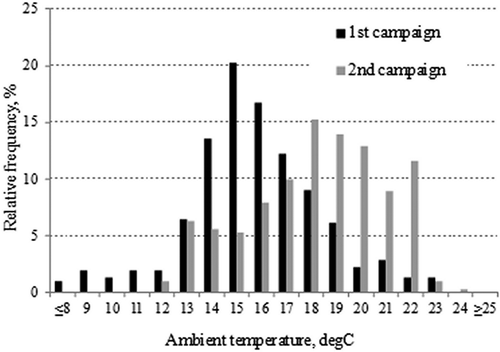
Wind-rose graphs of the two monitoring campaigns are reported in . It was observed that during the first monitoring campaign, the wind was blowing predominantly from southwest (SW) sector, whereas in the second campaign the wind direction was more variable, with east-northeast (ENE) as prevailing sector and a not negligible south contribution from the SW. Results correspond to typical wind patterns observed in Naples during spring and autumn/winter, respectively. In fact, during spring, the prevailing wind direction is from south-southwest (SSW) and the second most frequent wind direction is from northeast (NE). In autumn/winter, these are still the prevailing wind directions, but the predominant wind is from north-northeast (NNE) and south-southeast (SSE) is the second most prevailing direction (Menna et al., Citation2007). As results from show, the urban area of Naples is mainly located at west, north, and east directions with respect to the port area. Therefore, wind flowing from south or southwest does not transport the pollutants from the urban area.
Figure 3. Wind-rose of first (left) and second (right) monitoring campaigns. Wind categories (m/sec) are 0.5–2.1; 2.1–3.6; 3.6–5.7; 5.7–8.8; 8.8–11.1; and >11.1.
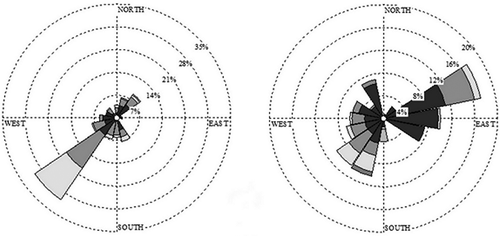
During the two campaigns, the number of daily arrivals and departures of passenger ships and crafts close to the studied area had been monitored. Fleet movements are summarized in . The daily schedule for the ferry/craft service remained unchanged between the two periods (see the average daily values in last rows of ), whereas the number of cruise ships more than doubled in the second period (Battistelli et al., Citation2012).
Table 1. Number of arrivals and departures of passenger ships and crafts in the harbor area during the two campaigns
Pollutant air concentrations in the port of Naples
Data of passive samplers and continuous analyzers were preliminarily filtered to eliminate the out-of-range values (outliers) based on a statistical analysis performed with Statgraphics (Centurion XVI). Outliers are identified as the points more than 3 interquartile ranges below the first quartile or above the third quartile. Then, average values of pollutant concentrations in the period and confidence intervals were evaluated. For passive samplers, average data correspond to the time-averaged concentration during the period (14 days in the first campaign and 19 days in the second one). Average, minimum, and maximum data of passive samplers relative to the first and second campaigns are reported in . The table also shows the 95% confidence intervals for passive samplers. For continuous analyzers, average values in the monitoring period are reported together with minimum and maximum of hourly average. The meaning of minimum and maximum values in vary significantly to the data of passive samplers and continuous analyzers. For passive samplers, data correspond to the time-averaged concentrations during the observation period measured at different sampling points. Therefore, differences between average, minimum, and maximum indicate the variability on a spatial scale. For the continuous analyzers, values are average, minimum, and maximum of hourly averages measured in the same place (at location F2). Therefore, the variability is, in this case, on a time scale.
Table 2. Concentration averages for the total measuring period (passive sampler) and 1-hr average concentrations (continuous analyzers)
Results of passive samplers measured at site F’ (average value of F1 and F2), close to the site of the mobile laboratory, were compared with those of continuous analyzers for SO2 and NO2. Comparison can be performed only for time-averaged values in the period. The time-averaged value of SO2 by passive samplers is 6.6 μg/m3, whereas by continuous analyzer it is 6.8 μg/m3. For NO2, the values are respectively 43.0 and 40.0 μg/m3. Therefore, results obtained by passive samplers can be compared with those obtained by continuous analyzers.
To assess the air quality in the port area, measured concentrations were compared with limit values established by European Commission (EC, Citation2008) in . Due to the limited number of days monitored during the two monitoring campaigns (on the whole 33 days in 1 yr), the comparison with limit values is only qualitative because the necessary minimum quantity of data was not collected. However, regulated pollutants (benzene, SO2, NO2, and PM10) are all below the limit values. In particular, the hourly limit value of 200 µg/m3 for NO2 and daily limit value of 50 µg/m3 for PM10 were always respected. Only time period average of NO2 (40.2 µg/m3) exceeded slightly the limit value for the annual average (40 µg/m3). It must be observed that this limit value is often exceeded in the urban area of Naples.
Table 3. Comparison of average values measured during the two monitoring campaigns with limit values (EC, Citation2008)
Furthermore, the air quality in the port of Naples is comparable to that of other Mediterranean ports, as shown in . The main difference is with respect to SO2 levels. Average concentration measured in Naples is between 6.8 and 8.2 μg/m3, whereas in Venice it is 3.7 μg/m3 and in Marseilles it is 0.8 μg/m3. The main reason, probably, lies in wind directions occurred during the monitoring campaigns in the three cities. In Marseilles, for example, Detournay et al. (Citation2011) measured two prevailing wind directions (northwest and southeast) during experimental activity; port activities contribute to SO2 pollution only when wind is from northeast.
Analysis of spatial distribution of atmospheric pollutants in the port area
Maps of spatial distribution of BTEX, SO2, and NO2 obtained by the analyses of passive samplers are reported in and for the two monitoring campaigns. Sites in the second campaign were less numerous due to the loss of several samplers. In and , proportionally sized pie charts were used.
Figure 4. First monitoring campaign: spatial distribution of measured BTEX, NO2, and SO2 concentrations.
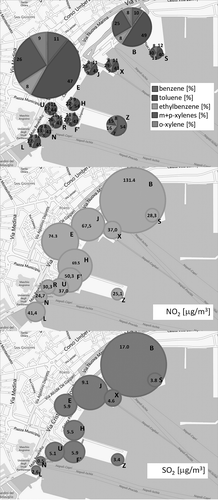
Figure 5. Second monitoring campaign: spatial distribution of measured BTEX, NO2, and SO2 concentrations.
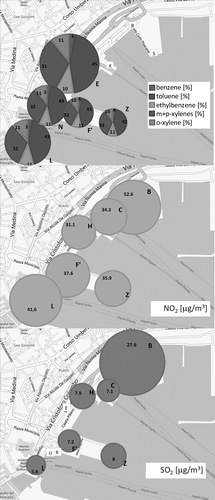
In the first campaign, a large homogeneity for BTEX can be observed, except for points E and B. The anomalous BTEX concentration observed at points E and B does not have a specific explanation due to their location. Point E is closer in respect to other points to the high-traffic road (via Cristoforo Colombo), whereas point B is at the border of the monitored area in the north direction but with apparently no specific pollutant sources that could justify the observed BTEX percentage. These points, in the preliminary statistical analysis performed, were identified as possible outliers. This could be a motivation to overlook them in the discussion of BTEX concentration. The percentage of the single BTEX, numbers inside each pie, is relatively constant apart from at point Z. Toluene covers the maximum percentage (40–49%), followed by m+p-xylenes (22–33%) and benzene, ethylbenzene, and o-xylene (all ranging between 8 and 15%). This distribution is typical in urban air where road transport is the main pollution source (Prestes de Castro et al., Citation2015). Point Z is, instead, characterized by the predominance of benzene (almost 54% of total BTEX). This observation should be explained by the different location of point Z: it is at the end of a berth and farther from road traffic. In other words, point Z is not directly influenced by road transport pollution and BTEX air concentration should be much more influenced by other parameters such as the reactivity of each compound in the atmosphere (toward OH and NO3 radicals), local ambient temperature, and humidity. Benzene is the less reactive compound, and sampling rate by passive samplers increases with temperature and humidity (Roukos et al., Citation2011). All these aspects should be some explanations for the anomalous BTEX distribution in point Z.
In the case of NO2 and SO2, a particular spatial variation is observed in the first campaign () where NO2 and SO2 seem to enhance moving from SW to NE. This finding is confirmed by correlations reported in and explained by the coefficient of determination R2. It is a measure of how well observed outcomes are replicated by a fitting curve or model and is calculated by eq 1:
Figure 6. Correlation of NO2 (up) and SO2 (bottom) concentration measured by passive samplers with position in SW-NE direction (first monitoring campaign).
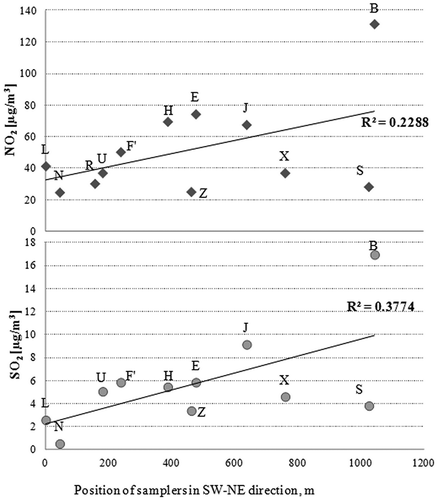
SSr and SSt are the residual sum of squares and the total sum of squares, respectively, and are defined by eqs 2 and 3:
Comparison between air quality in the port and in the urban area
Air pollutant concentrations measured inside the harbor of Naples were correlated with the air concentrations monitored by the urban air pollution network, operated by the Agency for Environmental Protection of the Region of Campania (ARPA Campania). The localization of air quality stations in the city of Naples is reported in . This comparison is justified by the proximity of the port and the urban area in Naples. As suggested by the legislation on air quality assessment in urban areas, the monitoring stations are classified as suburban background (SB; NA01), urban traffic (UT; NA02, NA03, NA04, NA05, NA06, NA07), and suburban traffic (ST; NA08, NA09).
The comparison of ambient air concentration measured in the port of Naples with that measured by the air quality monitoring stations in the urban area of Naples is reported in for NO2, PM10, and benzene. Unfortunately, data of SO2 from the air quality network of Naples were not available in either period of the two campaigns. Plots report the average values measured by each monitoring station over the observation time of the experimental campaign in the port of Naples. Data of nine monitoring stations are grouped for the first and second monitoring campaigns. Vertical lines represent the concentration measured by passive samplers and continuous analyzers in the port area. shows that concentration levels measured in the port area are generally comparable to those measured in the urban area. This is particularly true for PM10. For NO2 in the first campaign, concentration measured in the port area was higher than that in the urban area. For benzene, data measured in the different stations in the urban area are highly scattered and a comparison is difficult. However, in the second campaign, benzene concentration in the port area was lower than in the urban area.
Figure 7. Comparison of NO2, PM10, and benzene concentrations measured in the port area and in fixed stations in the urban area of Naples.
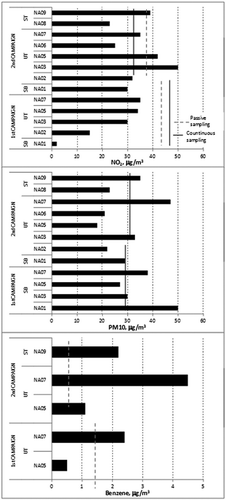
The significance of the comparison is strictly dependent on the duration of the two campaigns. The first one lasted 14 days in April and is representative of the spring season; the second one lasted 19 days in November and is representative of autumn. Since meteorological conditions observed were quite typical of the two seasons, the results obtained can be considered representative of the two seasons.
A time analysis was performed to verify the correlation of hourly average values measured in the port area with those measured at fixed stations in the urban area of Naples for NO2 and PM10. Results in terms of coefficient of determination R2 are reported in .
Table 4. Coefficient of determination (R2) for NO2 and PM10 between data measured in the port area and in the urban area of Naples
High correlation between data measured in the port area with data measured in the urban area was observed mainly for traffic-oriented stations (i.e., 2, 5, 6, and 7). Lower correlation is registered with background station (station 1) and suburban stations (stations 8 and 9). High correlation is also observed among stations of the same typology (i.e., traffic stations). Further to this, low correlation is observed among the urban area stations of different typology (i.e., station 9 with other). This is an indication that the phenomena determining the concentration levels of NO2 and PM10 in the port area have a time dependence similar to that registered at traffic stations located in the urban area of Naples.
Conclusions
The results of the two monitoring campaigns conducted in the port of Naples in 2012, even though not exhaustive, due to (i) the relatively short observation time (only 33 days in two different seasons: spring and autumn); (ii) the loss of numerous passive samplers particularly in the second campaign; and (iii) the unavailability of SO2 concentration from the Naples air quality network, supplied some useful indications.
The main indications are as follows:
About the air quality in the port of Naples, the results obtained have not indicated any particular problem. A proper comparison with limit values (LVs) established by European legislation would require a 1-yr observation period, a much longer time than the duration of our monitoring campaigns. However, it can be observed that NO2 hourly average (200 μg/m3) and PM10 daily average (50 μg/m3) concentrations were always below the respective LV. Time-averaged concentrations in the period for PM10 (29.8 μg/m3) and benzene (1.0 μg/m3) were below the respective yearly average LVs (40 μg/m3 for PM10 and 5 μg/m3 for benzene). Only NO2 average concentration in the period measured by passive samplers (41.1 μg/m3) exceeded slightly the year limit value (40 µg/m3). SO2 concentration was well below the hourly and daily average LVs. For the reasons stated above, a definitive assessment on the air quality in the port of Naples cannot be inferred from our data. However, it must be highlighted that results, even though relative to a limited range of days, were obtained with meteorological conditions typical of the two seasons monitored. Therefore, their time significance can be higher than the actual observation time.
Concentration levels of BTEX, NO2, and PM10 are comparable to those registered in the urban area of Naples. A time dependence analogous with urban traffic-oriented stations of the air quality network sited in Naples urban area was also observed. For SO2, the comparison was not possible to operate because of the unavailability of data from the air quality network stations in the urban area of Naples.
Concentrations monitored are also comparable to those observed by other authors in other Mediterranean ports. Only SO2 showed concentration levels higher than those observed in other ports. Regardless, absolute values of this pollutant are very low.
A preliminary attempt to assess the impact of naval emissions on the ambient air concentration level in the port area based on the analysis of the spatial variation of concentration along the SW-NE direction has shown that SO2 concentration in the port area may be affected by naval emissions more than other pollutants. For other pollutants (NO2 and PM10), a high correlation between concentrations measured in the port area and urban area was observed for urban traffic oriented stations. These findings, even though not definitive as highlighted at the beginning of this section, seem to indicate that ship emissions do not constitute the unique source of air pollution in the port of Naples, a considerable contribution coming from the nearby urban traffic roads. Moreover, it is not possible to conclude that ship emissions from the port area have a significant impact on air quality in the city.
Further studies are necessary in order to make a more precise assessment of the contribution of ship emissions to the air quality in the urban area of Naples. On the basis of the results of this study, the following activities would be necessary: (i) development of a bottom-up procedure for a reliable time dependent emission database of ship emissions due to maneuvering and hotelling at berths in the port of Naples; (ii) the use of models for the individuation of the fate of atmospheric pollutants emitted by ships on a local scale of few kilometers from the sources; (iii) the realization in 1 yr of at least four monitoring campaigns each lasting 15 days in each of the four seasons. Passive samplers, necessary for the coverage of such a large area, would be associated with two or three mobile laboratories equipped with analyzers for PM10, NO2, SO2, and BTEX. If SO2 data were still unavailable from the “Regional Air Quality Network,” it would be necessary to provide for the use of two to three analyzers located in the urban area of Naples.
Acknowledgment
The authors are grateful to the Port Authority of Naples for the permission to perform the experimental activity and for the technical support for its realization. The authors wish to thank Prof. Marco Trifuoggi and Dr. Giuseppe Perretta for their analytical support.
Funding
This work has been developed in the framework of Italian Flagship Project (Progetto Bandiera) RITMARE 2012–2016 funded by the Italian Ministry of University and Research (MIUR).
Additional information
Funding
Notes on contributors
Maria Vittoria Prati
Maria Vittoria Prati and Maria Antonietta Costagliola are researchers of CNR (National Council of Research).
Maria Antonietta Costagliola
Maria Vittoria Prati and Maria Antonietta Costagliola are researchers of CNR (National Council of Research).
Franco Quaranta
Franco Quaranta is researcher in Naval Engineering at the University of Naples Federico II.
Fabio Murena
Fabio Murena is associate professor in Chemical Engineering at the University of Naples Federico II.
References
- Adamo, F., G. Andria, G. Cavone, C. De Capua, A. Lanzolla, R. Morello, and M. Spadavecchia. 2014. Estimation of ship emissions in the port of Taranto. Measurement 14:982–988. doi:10.1016/j.measurement.2013.09.012
- American Public Health Association (APHA), American Water Works Association (AWWA), Water Environment Federation (WEF). 1998. Standard Methods for the Examination of Water and Wastewater, 20th ed. Washington, DC: American Public Health Association.
- ARPAV (Agenzia Regionale per la Prevenzione e Protezione Ambientale del Veneto). 2012. Campagna di monitoraggio della qualità dell’aria—Comune di Venezia—Area portuale San Basilio. http://www.arpa.veneto.it/arpav/chi-e-arpav/file-e-allegati/dap-venezia/aria/dap-venezia-campagne-di-monitoraggio-qualita/comune-di-venezia/Relazione_campagna_San_Basilio_2012.pdf ( accessed October 2014).
- Ault, A.P., M.J. Moore, H. Furutani, and K.A. Prather. 2009. Impact of emissions from the Los Angeles port region on San Diego air quality during regional transport events. Environ. Sci. Technol. 43:3500–3506. doi:10.1021/es8018918
- Battistelli, L., T. Coppola, M. Fantauzzi, and F. Quaranta. 2012. The environmental impact of cruise ships in the port of Naples: Analysis of the pollution level and possible solutions. J. Maritime Res. 9:81–86.
- Cesari, D., A. Genga, P. Ielpo, M. Siciliano, G. Mascolo, F.M. Grasso, and D. Contini. 2014. Source apportionment of PM2.5 in the harbour–industrial area of Brindisi (Italy): Identification and estimation of the contribution of in-port ship emissions. Sci. Total Environ. 497–498:392–400. doi:10.1016/j.scitotenv.2014.08.007
- Contini, D., A. Gambaro, F. Belosi, S. De Pieri, W.R.L. Cairns, A. Donateo, E. Zanotto, and M. Citron. 2011. The direct influence of ship traffic on atmospheric PM2.5, PM10 and PAH in Venice. J. Environ. Manage. 92:2119–2129. doi:10.1016/j.jenvman.2011.01.016
- Detournay, A., J. Pey, N. Perez, M.C. Bove, V. Ariola, E. Cuccia, D. Massabò, P. Prati, J.G. Bartzis, D. Saraga, E. Tolis, K. Filiou, A. Latella, A. De Bortoli, F. Liguori, S. Patti, and N. Marchand. 2011. Intercomparison campaign (WP3.4): First progress report. http://www.apice-project.eu/img_web/pagine/files/Results/Intercomparison%20Campaign%20-%20Progress%20Report.pdf ( accessed October 2014).
- Donateo, A., E. Gregoris, A. Gambaro, E. Merico, R. Giua, A. Nocioni, and D. Contini. 2014. Contribution of harbour activities and ship traffic to PM2.5, particle number concentrations and PAHs in a port city of the Mediterranean Sea (Italy). Environ. Sci. Pollut. Res. 21:9415–9429. doi:10.1007/s11356-014-2849-0
- European Commission (EC). 2002. Quantification of emissions from ships associated with ship movements between ports in the European Community—July 2002. http://ec.europa.eu/environment/air/pdf/chapter1_ship_emissions.pdf
- European Commission (EC). 2008. Directive 2008/50/EC of the European Parliament and the Council of 21 May 2008 on ambient air quality and cleaner air for Europe. Official Journal of the European Union 11.6.2008.
- Gariazzo, C., V. Papaleo, A. Pelliccioni, G. Calori, P. Radice, and G. Tinarelli. 2007. Application of a Lagrangian particle model to assess the impact of harbour, industrial and urban activities on air quality in the Taranto area, Italy. Atmos. Environ. 41:6432–6444. doi:10.1016/j.atmosenv.2007.06.005
- Healy, R.M., I.P. O’Connor, S. Hellebust, A. Allanic, J.R. Sodeau, and J.C. Wenger. 2009. Characterisation of single particles from in-port ship emissions. Atmos. Environ. 43:6408–6414. doi:10.1016/j.atmosenv.2009.07.039
- ISPRA (Istituto Superiore per la Protezione e la Ricerca Ambientale). 2012. Qualità dell’ambiente urbano—VIII Rapporto Annuale. http://www.isprambiente.gov.it/it/pubblicazioni/stato-dellambiente/qualita-dellambiente-urbano-viii-rapporto.-edizione-2012 ( accessed October 2014).
- ISPRA (Istituto Superiore per la Protezione e la Ricerca Ambientale). 2014. Italian Emission Inventory 1990–2012. Informative Invertoty Report 2014. http://www.isprambiente.gov.it/files/pubblicazioni/rapporti/R_201_14_IIR_2014.pdf ( accessed January 2015).
- Lucialli, P., P. Ugolini, and E. Pollini. 2007. Harbour of Ravenna: The contribution of harbour traffic to air quality. Atmos. Environ. 41:6421–6431. doi:10.1016/j.atmosenv.2007.05.003
- Marr, I.L., D.P. Rosser, and C.A. Meneses. 2007. An air quality survey and emissions inventory at Aberdeen Harbour. Atmos. Environ. 41:6379–6395. doi:10.1016/j.atmosenv.2007.04.049
- Matthias, V., I. Bewersdorff, A. Aulinger, and M. Quante. 2010. The contribution of ship emissions to air pollution in the North Sea regions. Environ. Pollut. 158:2241–2250. doi:10.1016/j.envpol.2010.02.013
- Menna, M., A. Mercatini, M. Uttieri, B. Buonocore, and E. Zambianchi. 2007. Wintertime transport processes in the Gulf of Naples investigated by HF radar measurements of surface currents. Nuovo Cimento 30:605–622. doi:10.1393/ncc/i2008-10270-0
- Mueller, D., S. Uibel, M. Takemura, D. Klingelhoefer, and D.A. Groneberg. 2011. Ships, ports and particulate air pollution - an analysis of recent studies. J Occup Med Toxicol 6:1–6. doi:10.1186/1745-6673-6-31
- Pérez, N., and J. Pey. 2011. APICE intensive air pollution monitoring campaign at the port of Barcelona. http://www.apice-project.eu/img_web/pagine/files/Long%20monitoring%20campaign%20APICE.pdf ( accessed October 2014).
- Prestes de Castro, B., G. de Souza Machado, G. Favila Bauerfeldt, J.D.N. Fortes, and E. Monteiro Martins. 2015. Assessment of the BTEX concentrations and reactivity in a confined parking area in Rio de Janeiro, Brazil. Atmos. Environ. 104:22–26. doi:10.1016/j.atmosenv.2015.01.013
- Roukos, J., N. Locoge, P. Sacco, and H. Plaisance. 2011. Radial diffusive samplers for determination of 8-h concentration of BTEX, acetone, ethanol and ozone in ambient air during a sea breeze event. Atmos. Environ. 45:755–763. doi:10.1016/j.atmosenv.2010.09.012
- Saxe, H., and T. Larsen. 2004. Air pollution from ships in three Danish ports. Atmos. Environ. 38:4057–4067. doi:10.1016/j.atmosenv.2004.03.055
- Schembari, C., F. Cavalli, E. Cuccia, J. Hjorth, G. Calzolai, N. Pérez, J. Pey, P. Prati, and F. Raes. 2012. Impact of a European directive on ship emissions on air quality in Mediterranean harbours. Atmos. Environ. 61:661–669. doi:10.1016/j.atmosenv.2012.06.047
- Viana, M., P. Hammingh, A. Colette, X. Querol, B. Degraeuwe, I. de Vlieger, and J. van Aardennee. 2014. Impact of maritime transport emissions on coastal air quality in Europe. Atmos. Environ. 90:96–105. doi:10.1016/j.atmosenv.2014.03.046
- Zhao, M., Y. Zhang, W. Ma, Q. Fu, X. Yang, C. Li, B. Zhou, Q. Yu, and L. Chen. 2013. Characteristics and ship traffic source identification of air pollutants in China’s largest port. Atmos. Environ. 64:277–286. doi:10.1016/j.atmosenv.2012.10.007

